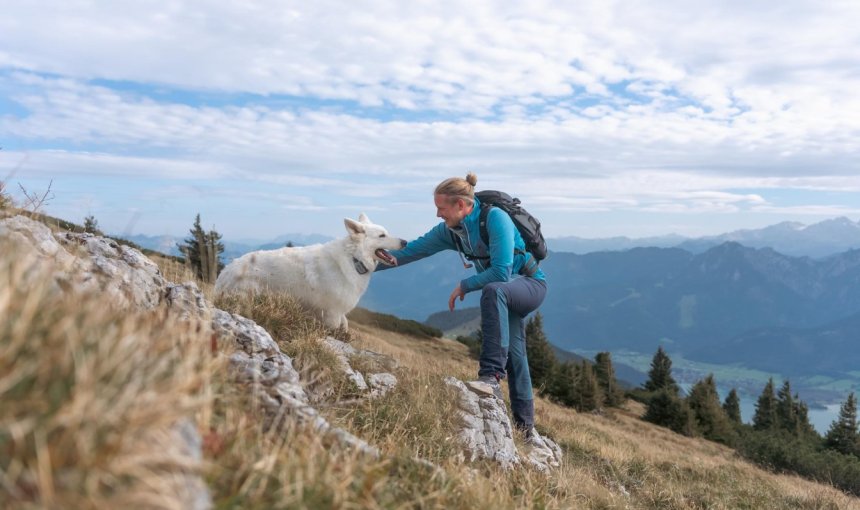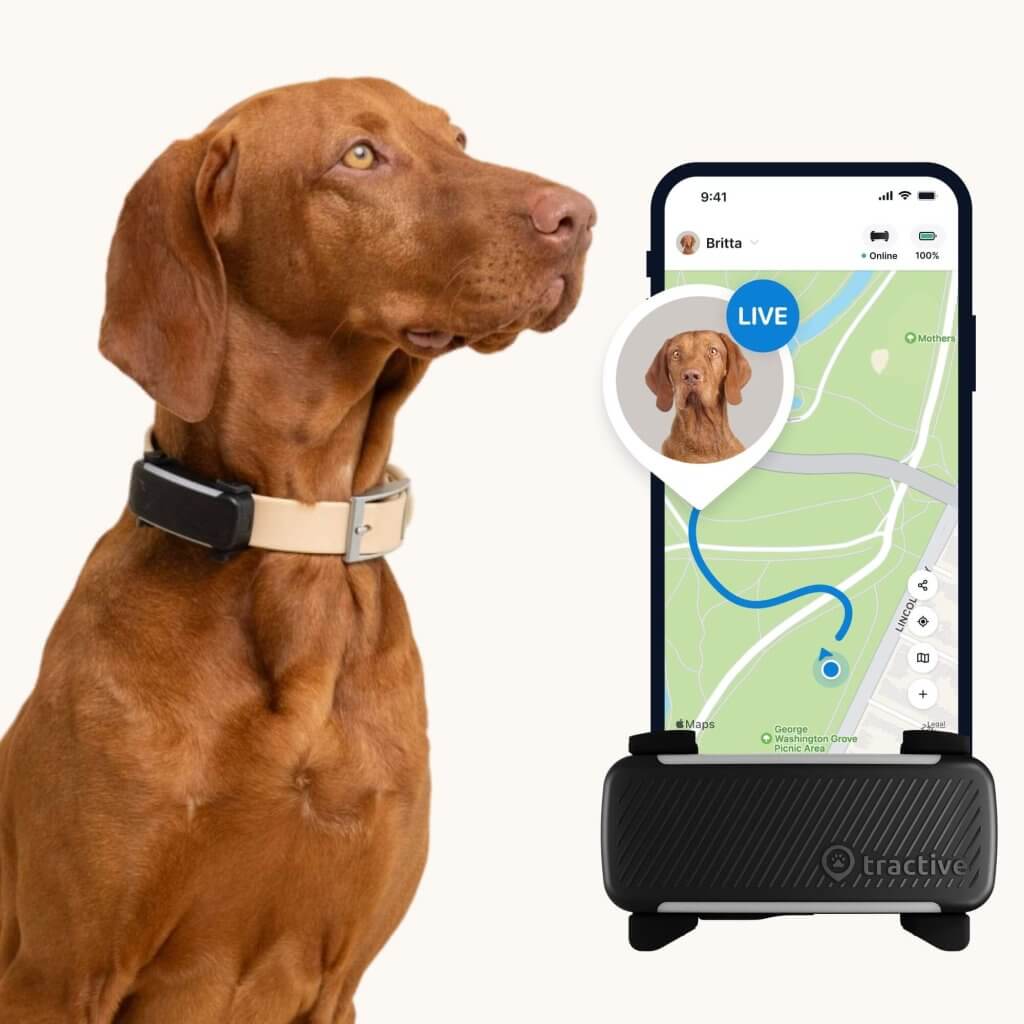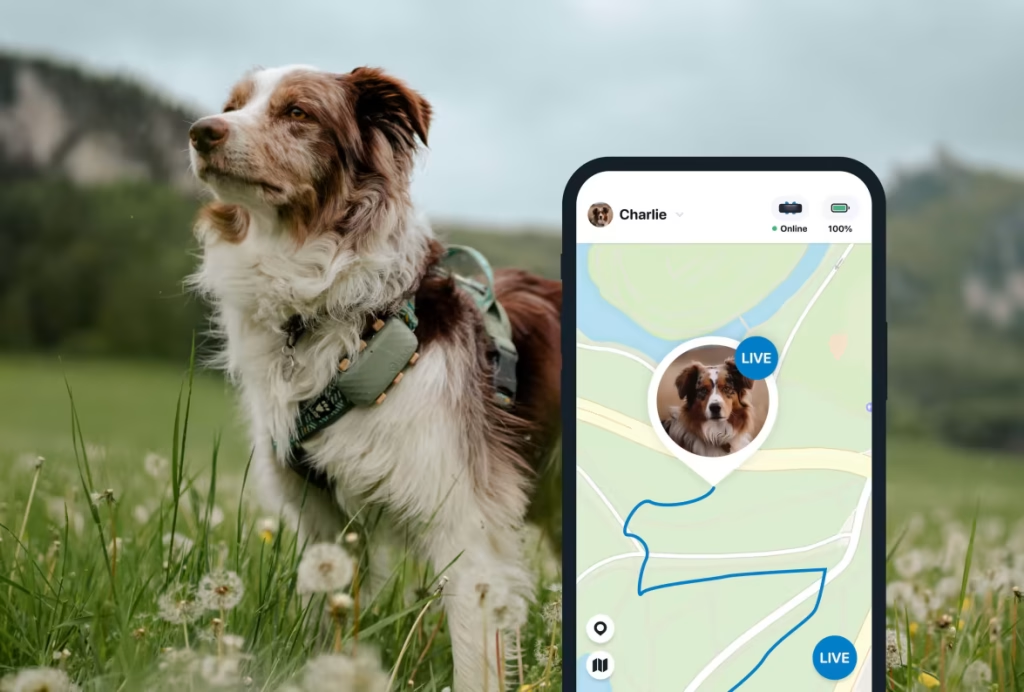How To Go Camping With Dogs Like A Pro
Think you're ready to go camping with your dog? Here's a comprehensive list of everything you need to keep them safe & you sane.

As the weather gets nicer, you might’ve considered taking your buddies out on runs, hikes – or even camps out in the wild. So here are our top tips on how to go camping with dogs and return home with your sanity intact. (Including the best way to prevent a lost dog situation out in the woods or wilderness.)

Always know your buddy is healthy & safe
Read more- What to consider if you’d like to go camping with dogs
- What to do before you take your dogs out camping
- What to keep in mind when picking a dog-friendly camping spot
- Where should my dog sleep?
- More useful items when you’re out camping with dogs
- Our top safety tips for when you’re out camping with dogs
- What do I do if one of my dogs goes missing while out camping?
What to consider if you’d like to go camping with dogs
For many of us humans, camping trips take us outside of our comfort zone. The same applies for camping with dogs – meaning your buddies’ personality, activity level, age, and how well-trained they are can all play a role in whether you’ll all enjoy yourselves…or come home swearing you’ll never take them out with you again.
So before you head out, consider:
- Are your dogs likely to get a bit over-excited at the new sights, sounds, and smells at the campground?
- Can your dogs get along with other dogs?
- Do any of your dogs bark incessantly? (That’s a surefire way to annoy all the other campers!)
- Do your dogs respond to basic commands like Come, Sit, and Stay? These skills help maintain control of your pooch in the stimulating outdoor environment.
- Are your buddies on the younger side? (You know how rambunctious puppies can get – and a litter of them together can be a nightmare.)
- Are your buddies on the older side? Senior dogs might be better off with gentle hiking trails and need more frequent breaks.
- Do your dogs tend to chase down every squirrel or woodland animal they run into?
- Do your dogs have a ton of energy to burn and need more exercise to relax?
💡A dog GPS tracker can be a potential lifesaver if you have a dog with high prey drive, still in progress with their training, a bundle of energy, or just a scaredy-dog. (Aka, more likely to run away from you and disappear into the undergrowth.) With just a glance at your phone, you’ll be able to track your dog in real-time, plus over an unlimited range.

Follow your dog anywhere
Get real-time location information, wherever they go. And find out when they try to make an escape, or just when they go somewhere they shouldn’t, with Virtual Fences.
What to do before you take your dogs out camping
- Drop by your vet before the trip
Ensure your buddies are up to date on their vaccine shots – especially rabies. Camping with dogs also means mosquitoes – which means they’re at risk for picking up heartworm. - Make sure your dogs are easy to identify
A collar with an ID tag is always a good practice. But if you’re planning on camping off-grid where cell service isn’t the best, consider getting your dogs microchipped. - Do a practice camping trip in your backyard
Set up a tent in your backyard and hang out together inside. Feed your dogs in the tent and place their beds and toys inside to help them familiarize themselves. Take a few daytime naps (or an overnight sleep) together in a hammock. If your dogs can ignore all the distractions and stay by your side, they might do well when out camping with you. - Socialize with people and other dogs
While out on walks or at the dog park. Besides helping your buddies develop their own social skills and learn to behave, it can also help them get better prepared for camp life. - Get the lay of the land
Before your camping trip, research your destination. Will you be mostly outdoors, sightseeing in town, or visiting family? If you plan to do lots of hiking, build up your dog’s stamina by taking longer walks each day. If your dog is older or has health issues, plan to adjust your daily activities to accommodate them.
What to keep in mind when picking a dog-friendly camping spot
Not all campgrounds welcome dogs, so make sure to call ahead and reserve your dog friendly campsite early so you won’t be disappointed. Private campgrounds, state or provincial parks, and national forests are most likely to be dog friendly. National parks in the United States do not allow pets in the backcountry, so you won’t be able to hike with your pup, but pets are allowed in some developed areas of national parks.
Besides, you should also:
- Keep in mind the “unwritten rules” when out camping
Most camping sites require dogs to be on leash at all times. Leashes can also be no more than 6 feet long. Likewise, always ask before allowing your dog to approach other people or pets in the campground and respect quiet hours. (Usually between 11 PM to 7 AM.) - Don’t leave your dogs alone while out camping
Never tether your dogs alone in a campsite. They’re at risk of running afoul the local wildlife, approached by small children, or even tangled up. If you do tether your dog while you relax or prepare food, ensure that your buddy can’t reach walking paths where people are likely to pass by. Likewise, never leave them along in the car or your RV while you enjoy a hike. Vehicles can become dangerously hot for pets, even with the windows open. - Be extra mindful of what your dogs eat while out camping
Common camping food items like Trail Mix, for example, might contain ingredients like chocolate or raisins – both of which can be fatally toxic to dogs. Your dogs might even invade a fellow camper’s grill or even sniff out roadkill out in the woods.
Where should my dog sleep?
Your dog should sleep in your tent, camper, or RV – wherever you’re sleeping! Your tent or camper is the safest place for your dog to sleep on your camping trip. Unless you enjoy ceding the floor space to a sprawled-out dog, bring a crate for your dog to sleep in. Or, buy a larger tent for camping with your dog.
If you sleep in a tent, you have to consider that dogs take up a lot of space. It’s not a bad idea to get a larger tent so that everyone will be comfortable.
- Do you want your dog to sleep next to you or in their crate? Some tents have a vestibule with no floor, which is a good spot for the crate.
- Bring your dog’s bed or a familiar-smelling rug to increase their comfort level.
- For camping in cold weather, try a dog sleeping bag. Some can attach to your sleeping bag for extra snuggles and warmth.
Tie-outs, kennels & pens
You probably don’t want to hold your dog’s leash during your entire camping trip, so use a tie-out, crate, or pen at your campsite. After all, you’ll be busy maintaining your camp, prepping meals, or possibly napping after a long hike.
Dogs often get tangled up in a tied-out line. Instead, string a line between two trees and attach the leash that can slide along the line. Place this in the shade so your dog can stay cool.
A pen or crate gives your dog a safe place to relax or sleep. When you need to visit the restroom or shower, keep your dog safely inside their crate in the tent.
More useful items when you’re out camping with dogs
- Harness & leash
Harnesses are more comfortable than collars and less likely to make your dogs choke against them. You can even attach LED lights to one easily – if you need help tracking down your dog in areas with poor visibility. - A dog first-aid kit
Including basic first aid items like gauze, wet wipes, bandages, and a pair of tweezers. Print out your dog’s medical records and keep your vet’s phone number at hand. If your dogs take medication, bring enough for your expected stay plus a few extra days in case your return home is delayed. - More dog food & water than you think you need
Camping is an active adventure, so your pup will burn more energy and need up to half as much more dog food than they normally consume. Collapsible dog bowls are a great way to serve dog food and give your pooch a refreshing drink on the trail and at the campsite. - Some of your dog’s favorite toys
Some campgrounds have fenced-in dog parks where your pup can run off leash or play a game of catch. Bring along their favorite balls, frisbees, or tug-of-war ropes to keep them occupied. - Poop bags
If you are in a full-service campground, collect dog waste in poop bags and dispose of the poop bags in the proper trash container. If you are camping in the wilderness, collect the waste in a poop bag, pack it out, and dispose of it properly when you get to a trash bin. Do not bury a poop bag – the plastic bag won’t decompose. But if you’re deep in the wilderness, it’s OK to bury unbagged poop at least 200 feet from a trail, creek, or any water source.
Our top safety tips for when you’re out camping with dogs
- Protect your dog’s paws
Camping may expose your dog’s paws to rough or hot surfaces (like sand) that can irritate sensitive foot pads, so outfit your pup with dog booties. Hiking-style booties provide good traction. - Plan ahead for cold weather
Small dogs and those with short hair are more likely to need a bit more layers. Bring booties to keep their feet warm during hikes. Offer a warm sleeping surface, such as a dog bed or rug, and a blanket if it’s really cold. - Watch out for fleas, mites & ticks
At your pre-camping veterinary visit, ask about flea and tick protection for your dog. Every evening, do a tick check of your dog. Bring a tick removal device, called a tick key, and use it to safely disengage ticks. Use a comb to remove grass barbs from your dog’s fur, then give your pup a good brushing. - Locate a vet near the campsite
Before you depart, locate a veterinarian or emergency animal clinic in the area you are visiting. Hopefully you won’t need it, but it’s better to be prepared should an emergency arise. - Watch out for heat stroke in warm weather
Try hiking in the early morning to stay cool. Stop for frequent water breaks to avoid dehydration. If your pup is panting, stop and rest in a shady spot. Don’t restart the hike until your pup has cooled off.
What do I do if one of my dogs goes missing while out camping?
Nothing is worse than losing track of your pet, especially in a remote or unfamiliar area. Like we’ve covered, it only takes a few seconds of you turning the other way to get that perfect shot or selfie – and now your dog’s bounding away, a mile a minute.
- Stay calm and call out your dog’s name
It’s highly likely they haven’t gotten far. Call their name in a calm voice and avoid shouting in a panic. - Retrace your steps
Dogs often follow familiar scents, so check areas where you’ve recently been together. If possible, leave an item with your scent, like a jacket or blanket, near your campsite. Check any water sources (like streams, lakes, or rivers) or shaded spots (like dense foliage) near you. Your dog might instinctively seek water or shade if they’re thirsty or tired.
- Let your fellow campers know
Including park rangers and nearby hikers. Keep some photos of your dog handy and notify the camp staff, any local vets, and animal shelters nearby. - Use a GPS tracker as an emergency measure
If your dog is wearing a Tractive GPS Tracker, activate LIVE Tracking to see their real-time location and follow their movements. Or you could check your dog’s Location History to figure out what spots around you they’ve been spending time in the most. And to prevent them from escaping again, set up a “safe zone” around your camp perimeter – and get an escape alert if your dog tries sneaking past it.




